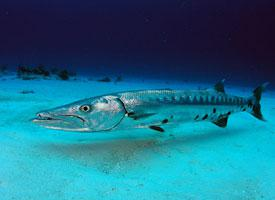
Váhy a míry
| Délka | od 0,45 do 2,8 m |
|---|---|
| Hmotnost | 40 kg |
Biologická data
| Délka života | od 10 do 12 let |
|---|
Popis zvířete
The Great Barracuda (Sphyraena barracuda) is a striking marine fish, notorious for its formidable appearance and predatory prowess. Native to the warmer waters of the Atlantic Ocean, the Caribbean Sea, and the western Indo-Pacific region, this species is a prominent figure in both coastal and open ocean environments.Characterized by its elongated, torpedo-shaped body, the Great Barracuda can reach lengths of up to 6 feet (1.8 meters) and weigh as much as 50 pounds (23 kilograms), though specimens of this size are rare. The body is covered in small, smooth scales, and its coloration can vary from a silvery hue to a darker, almost greenish tint on the back, with lighter undersides. This coloration provides excellent camouflage in the water, allowing the barracuda to ambush prey with lethal efficiency.
One of the most distinctive features of the Great Barracuda is its large, pointed head and a fearsome array of sharp, fang-like teeth. These teeth are perfectly adapted for slicing through the flesh of its prey, which includes a wide variety of fish, cephalopods, and occasionally even smaller members of its own species. Its jaw is incredibly powerful, and its bite is swift, making the Great Barracuda a top predator in its environment.
The Great Barracuda possesses a remarkable burst of speed, thanks to its streamlined body and powerful tail fin, which it uses to ambush prey or escape potential threats. It is known to be a solitary hunter, but juveniles are often found in shallow, protected waters where they form schools that offer safety in numbers.
Despite its fearsome reputation, attacks on humans are exceedingly rare and typically result from mistaken identity in murky waters. Nonetheless, the Great Barracuda is respected by divers and fishermen alike for its impressive size, speed, and agility.
In terms of reproduction, the Great Barracuda is oviparous, meaning it lays eggs. Spawning occurs in the warmer months, with eggs being released and fertilized in open water. The larvae are planktonic, drifting with ocean currents until they are large enough to fend for themselves.
The Great Barracuda is an apex predator, playing a crucial role in maintaining the balance of marine ecosystems by controlling the population of smaller fish species. However, like many marine species, it faces threats from overfishing and habitat loss. In some regions, the Great Barracuda is also known to accumulate high levels of ciguatoxin in its flesh, a toxin that can cause ciguatera fish poisoning in humans if ingested.
Overall, the Great Barracuda is a fascinating and vital component of tropical and subtropical marine environments, embodying the raw beauty and complexity of oceanic life. Its existence underscores the importance of marine conservation efforts to ensure the health and diversity of the world's oceans for future generations.
Nové fotografie zvířat
Top 10 zvířat
- Dolphin gull (Leucophaeus scoresbii)
- Diana monkey (Cercopithecus diana)
- Stone loach (Barbatula barbatula)
- Greek tortoise (Testudo graeca)
- Moustached guenon (Cercopithecus cephus)
- Japanese macaque (Macaca fuscata)
- Galápagos tortoise (Geochelone nigra complex)
- Russian tortoise (Testudo horsfieldii)
- Galápagos penguin (Spheniscus mendiculus)
- Common flying dragon (Draco volans)